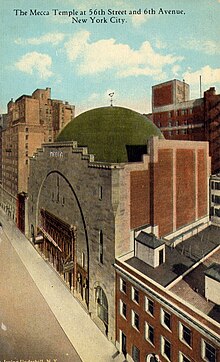New York City Center

Early Postcard of the Mecca Temple, New York City
|
|
| Address | 131 W. 55th St. New York, New York United States |
|---|---|
| Owner | City of New York |
| Operator | City Center 55th Street Theater Foundation |
| Type | Performing arts center Off-Broadway (MTC) |
| Capacity | Main stage: 2,257 Stage I: 300 Stage II: 150 |
| Construction | |
| Opened | 1922 (Main stage) 1984 (Stages I & II) |
| Architect | Harry P. Knowles and Clinton & Russell |
| Website | |
| www |
|
|
Mecca Temple
|
|
| Coordinates | 40°45′50″N 73°58′48″W / 40.76389°N 73.98000°WCoordinates: 40°45′50″N 73°58′48″W / 40.76389°N 73.98000°W |
| Area | less than one acre |
| Architectural style | Moorish |
| NRHP Reference # | 84002788 |
| Added to NRHP | September 07, 1984 |
New York City Center (previously known as the Mecca Temple, City Center of Music and Drama, and the New York City Center 55th Street Theater,) is a 2,257-seat Moorish Revival theater located at 131 West 55th Street between 6th and 7th Avenues in Manhattan, New York City. It is one block south of Carnegie Hall. City Center is especially known as a performing home for several major dance companies as well as the Encores! musical theater series and the Fall for Dance Festival. The facility houses the 2,257 seat main stage, two smaller theaters, four studios and a 12-story office tower.
The New York City Center, built in 1923, was designed by architect Harry P. Knowles and the firm of Clinton & Russell, and was originally called the Mecca Temple, by the Ancient Arabic Order of the Nobles of the Mystic Shrine, more commonly known as Shriners. The Shriners had previously held their meetings at Carnegie Hall. According to Broadway lore, Carnegie Hall management was disturbed by the amount of cigar smoke generated during Shriners meetings and evicted them. Although the Shriners owned a clubhouse at 107 West 45th Street, large meetings had earlier been held in Carnegie Hall and in the concert hall of Madison Square Garden (the 1890 Stanford White building).
In 1921, Mecca Temple bought the Famous Players-Lasky Corporation movie studio site from Yale University for $400,000. The cornerstone (visible today on West 56th Street) was laid on December 13, 1923 by Judge Arthur S. Tompkins, Grand Master of Masons in NY State. The dedication ceremony took place onstage, December 29, 1924, with the invocation offered by Episcopal Bishop William T. Manning. The first public musical concert took place late the next year, by John Philip Sousa's (a Mason) band, with Walter Damrosch and Willem Mengelberg among the audience.
...
Wikipedia



